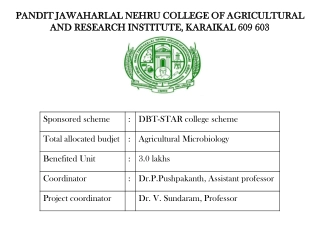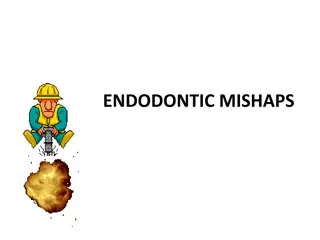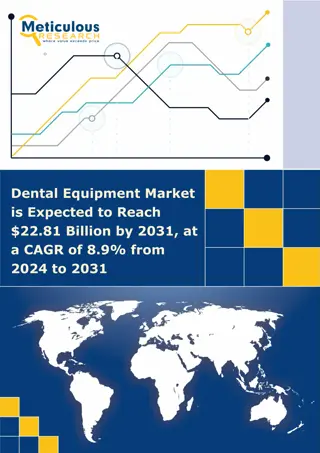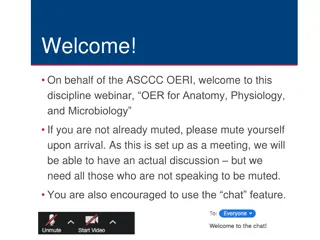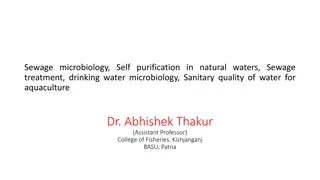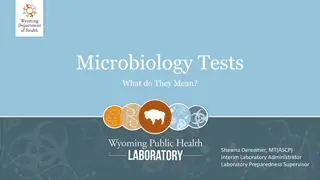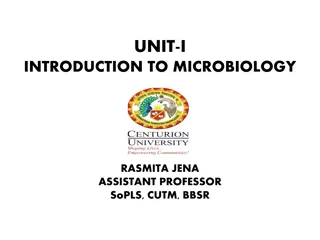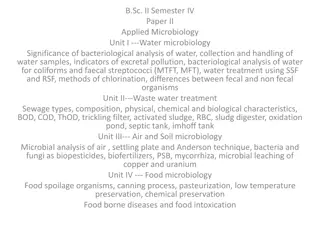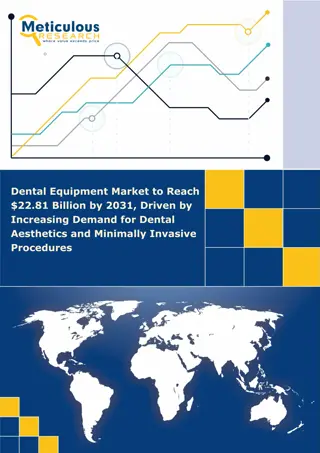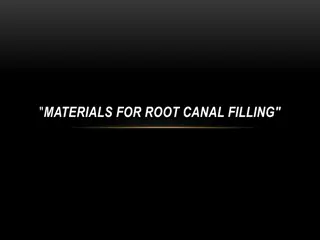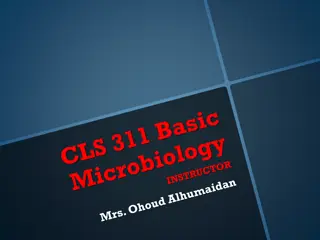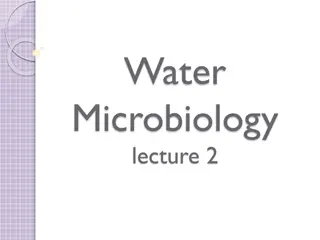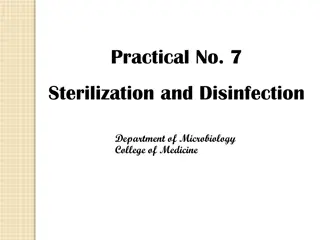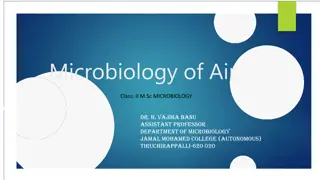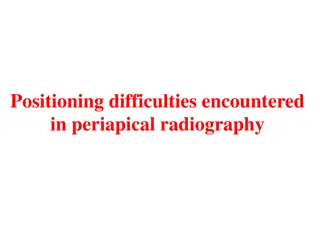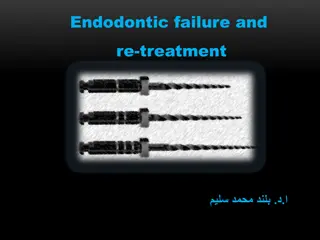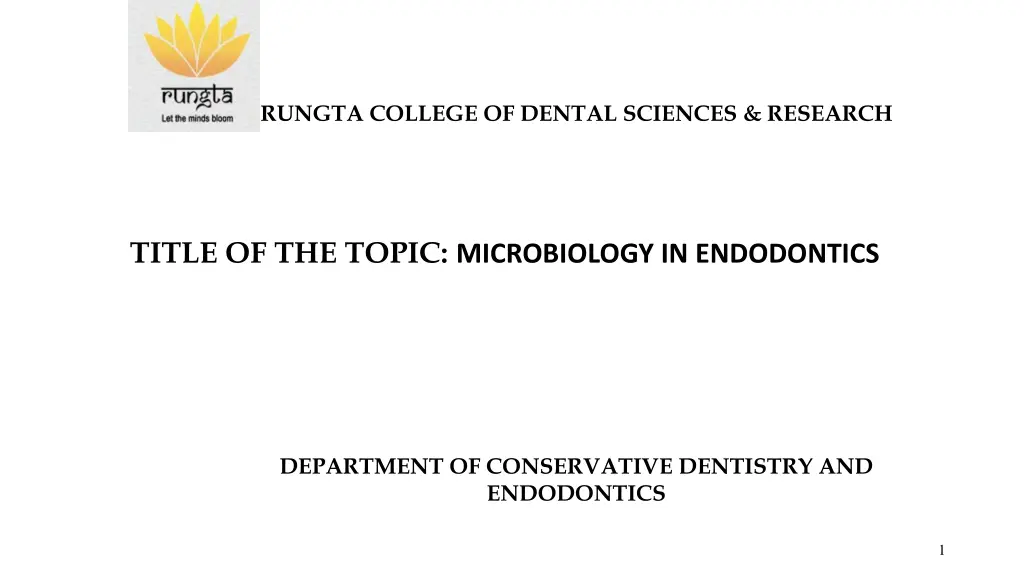
Microbiology in Endodontics: Routes of Microorganisms & Identification Methods
Explore the world of microbiology in endodontics with a focus on the routes of microorganism ingress, intraradicular and extraradicular infections, and methods for identifying microbes. Discover the role of molecular biology in studying human microbiota and uncovering new techniques for pathogen identification. Delve into the genes used for bacterial identification and the significance of 16S rRNA in inferring phylogenetic relationships.
Download Presentation

Please find below an Image/Link to download the presentation.
The content on the website is provided AS IS for your information and personal use only. It may not be sold, licensed, or shared on other websites without obtaining consent from the author. If you encounter any issues during the download, it is possible that the publisher has removed the file from their server.
You are allowed to download the files provided on this website for personal or commercial use, subject to the condition that they are used lawfully. All files are the property of their respective owners.
The content on the website is provided AS IS for your information and personal use only. It may not be sold, licensed, or shared on other websites without obtaining consent from the author.
E N D
Presentation Transcript
RUNGTA COLLEGE OF DENTAL SCIENCES & RESEARCH TITLE OF THE TOPIC: MICROBIOLOGY IN ENDODONTICS DEPARTMENT OF CONSERVATIVE DENTISTRY AND ENDODONTICS 1
Specific learning Objectives Specific learning Objectives At the end of this presentation the learner is expected to know Core areas* H Domain ** Category # Routes of microorganism, Microrganism associated with root canal infection Cognitive Must know Intraradicular infection, extraradicular infection Psychomotor Nice to know Methods of identification of microbes Affective Desire to know *Subtopic of importance ** Cognitive, Psychomotor or Affective # Must know , Nice to know & Desire to know 2
TABLE OF CONTENT: TABLE OF CONTENT: INTRODUCTION ROUTES OF MICROORGANISM INGRESS MICROORGANISMS FOUND IN ROOT CANALS ASSOCIATED WITH ENDODONTIC INFECTIONS INTRARADICULAR INFECTION EXTRARADICULAR INFECTION METHODS FOR IDENTIFICATION OF MICROBES 3
MOLECULAR BIOLOGY METHODS Development of MBT has provided vast array of new technique for study of human microbiota. Identification of previously unknown and uncharacterized human pathogens Revealed previously unanticipated diversity of human microbiota with as-yet-uncultivated bacteria (>50%) 4
He Several genes have been chosen as targets for bacterial identification 16S rRNA 23S rRNA 16S-23S rRNA gene internal transcribed sequences The rpoB gene encoding beta-subunit of RNA polymerase The groEL gene encoding the heat shock protein The gyrB gene encoding the beta-subunit of DNA gyrase Homologous recombination encoding recA 5
16S rRNA gene/DNAwidely used target universally distributed among bacteria Affords reliability for inferring phylogenetic relationships. 18S rRNA fungi &other eukaryotes 6
Plethora of molecular methods Broad range of PCR followed by cloning and sequencing to unravel the breadth of microbial diversity in a given environment Microbial communities can be analyzed via fingerprinting techniques denaturing gradiant gel electrophoresis(DGGE) & terminal restriction fragment length polymorphism(T-RFLP) 7
Fluorescence in situ hybridization (FISH) can measure abundance of target species and provide information on their spatial distribution in tissues Other app DNA-DNA hybridization arrays Species specific PCR Nested PCR Multiplex PCR Quantitative real time PCR 8
P.C.R AND ITS DERIVATIVES PCR method is based on the in vitro replication of DNA through repetitive cycles of denaturation, primer annealing and extension steps carried out in automated devices(thermocyclers) Can detect as few as 10 bacterial cells in sample with potential sensitivity to the one cell level Culture (nonselective media) 10 to 10 cells Selective media 10 9
Immunological methods 10 to 10 cells DNA-DNA hybridization 10 to 10 cells PCR 10 to 100 times more sensitive 11
Touchdown PCR Strategy to increase the specificity of the assay Useful to avoid the amplification of spurious DNA fragments (non target) 12
Nested PCR increased sensitivity, but also exhibit increase specificity advised mainly to have Multiplex PCR detection of different sp in a sample permits simultaneous Reverse transcriptase PCR amplify RNA targets & to exploit the use of the reverse transcriptase which can synthesize a strand of complementary DNA from RNA template developed to 13
PCR based microbial timing for clonal analysis and comparison of microbial isolates through PCR generated fingerprinting profile Real time PCR : usually qualitative / semi quantitative Allows the quantification of the amount of DNA Allows quantification of individual target sp as well as total bact 14
Advantages of real time PCR: rapidity Identify PCR products directly without the use of agarose gels Less contamination 15
Broad range PCR: used to investigate the breadth of microbial diversity Can detect the unexpected bacterial diversity Allows identification of various as-yet- uncultivated bacterial pathogens 16
Broad range PCR products can be alternatively analyzed by fingerprinting tech Genetic fingerprinting tech to determine the structure and diversity Denaturing gradient gel electrophoresis(DGGE) Terminal restriction fragement length polymorphism (T-RFLP) 17
DNA DNA- -hybridization hybridization Socransky et al( 94) Process of annealing the complementary bases of two single stranded DNA molecules Employs labeled DNA probes locate & bind to a target sequence, forming new duplex molecule. The labelled duplex can then be detected 18
Probes are segments of single stranded DNA labeled with detection milecules Constructed from either whole genomic DNA or oligonucleotides Genomic more likely to cross react with non target Oligonucleotide limited or no cross reactn 19
DNA microarrays DNA microarrays Schena et al ( 95) Consist of high density matrix of DNA probes, synthesized on glass/silicon slide Can be used to enhance PCR product detection and identification 20
FISH (fluorescence in situ hybridization) FISH (fluorescence in situ hybridization) Uses fluorescently labeled rRNA probes fluorescence microscopy to detect intact microbial cells Gives info presence, morphology, number, organization and spatial distribution Allows detection of not only cultivated sp but also 21
ADVANTAGES OF MOLECULAR BIOLOGY TECH: Detect both cultivated/as-yet-non sp High specificity High sensitivity Rapidity Do not require carefully controlled anarobic conditions during sampling and transportation used during antimicrobial treat Anarobic handling & expertise not required Samples can be stored frozen for later analysis Detect dead m.org 22
Limitations of MBT: Qualitative/semi quantitative (exp; real time PCR, microarray) Detect only 1 sp or few diff sp at a time (broad range,microarray) Detect only target sp & fails to detect unexpected sp (broad range) Some laborious & costly Hybridization- detect only cultivable sp 23
Teaching Materials Teaching Materials Endodontic practices - Grossman Pathways of pulp Cohen Textbook of Endodontics Nisha Garg Endodontics - Ingle 24
TAKE HOME MESSEGE/ FOR THE TOPIC COVERED (SUMMARY) TAKE HOME MESSEGE/ FOR THE TOPIC COVERED (SUMMARY) Infection of the root canal is not a random event. The type and mix of the microbial flora develop in response to the surrounding environment. Microorganisms that establish in the untreated root canal experience an environment of nutritional diversity. In contrast, well-filled root canal offers the microbial flora a small, dry, nutritionally limited space. Thus, we should obtain a better understanding of the characteristics and properties of bacteria and their biofilms along with the environmental changes, to enhance success. 25
Question & Answer Session DESCRIBE MOLECULAR BIOLOGY METHODS OF DETECTION OF MICRORGANISM 26
REFERENCES Endodontic practices - Grossman Pathways of pulp Cohen Textbook of Endodontics Nisha Garg Endodontics - Ingle 27
THANK YOU 28

